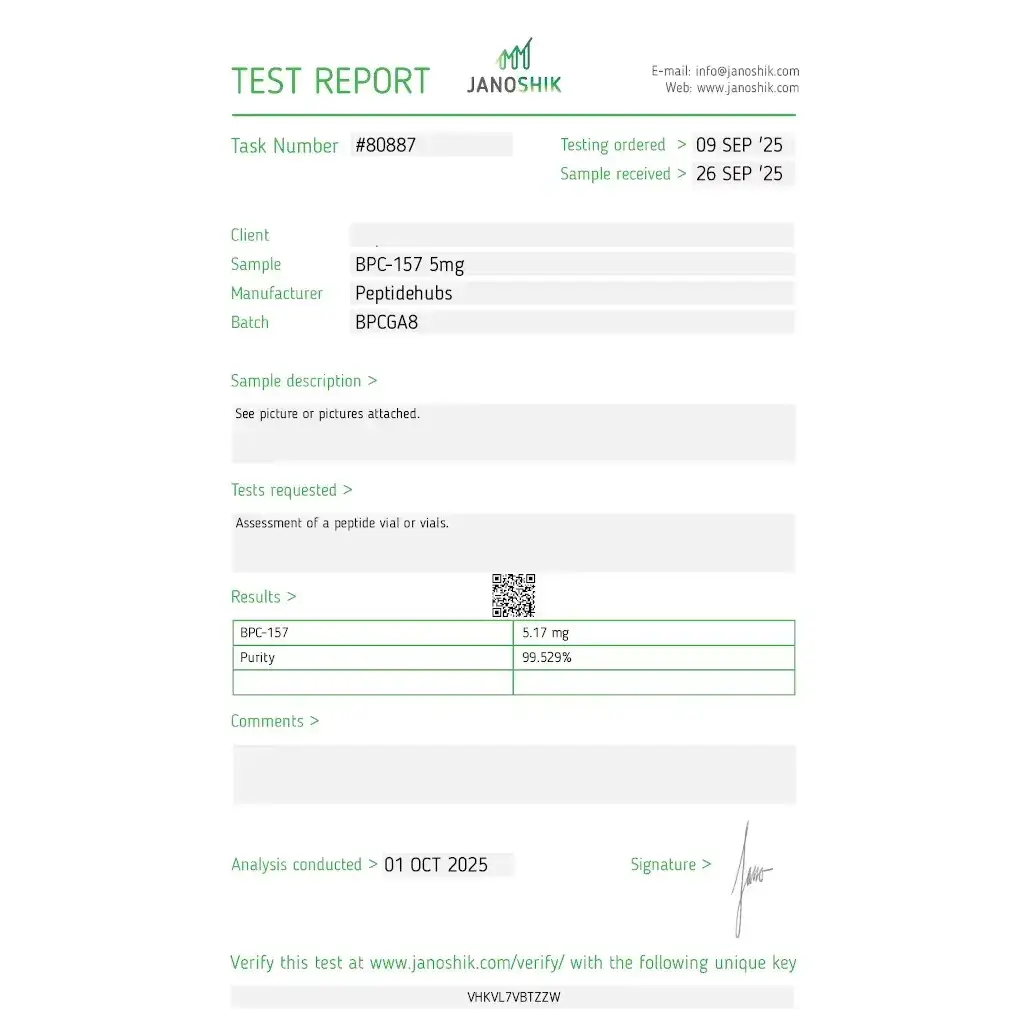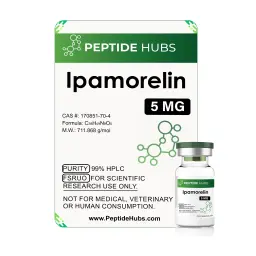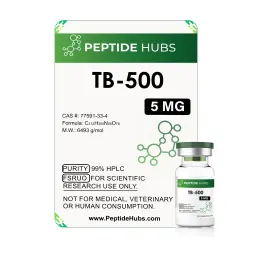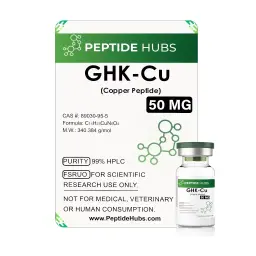





Drug Class: Synthetic Pentadecapeptide
Composition: BPC 157
Dosage: 5 mg/vial
Form: Lyophilized Powder
Unit: 2 mL Vial
Brand: Peptide Hubs
Laboratory Test: View Lab Report
For Research and Laboratory Use Only
For researchers focused on the cutting edge of tissue repair and recovery, Peptide Hubs presents its premium BPC 157 5 mg. This stable, synthetic pentadecapeptide is renowned for its remarkable ability to accelerate the healing of a wide variety of tissues, from muscles and tendons to ligaments and the gastrointestinal tract. Sourced and stocked within the USA, our BPC 157 is provided as a pure, lyophilized powder in a sterile 2 mL vial, ready for your precise research protocols.
At Peptide Hubs, we back our claims with verifiable data. Each batch of our BPC 157 is subjected to rigorous third-party laboratory testing, confirming its purity and dosage accuracy, ensuring you receive a reliable and potent research compound every time you buy BPC 157 USA from us.
BPC 157, which stands for Body Protecting Compound-157, is a synthetic peptide chain comprised of 15 amino acids. It is a partial sequence of the Body Protection Compound (BPC) found naturally in human gastric juice. This peptide has garnered significant attention in scientific literature for its potent systemic healing effects. Research published in the World Journal of Gastroenterology highlights its "beneficial effect in the healing of different tissues and organs" through multiple mechanisms, including promoting angiogenesis (formation of new blood vessels) and modulating growth factor expression.
The effects of BPC 157 in research models are broad and profound, making it a cornerstone for studies on recovery and resilience. Key observed effects include:
Important: The following information is based on common research protocols and is provided for educational purposes only. Researchers must consult scientific literature to determine appropriate dosages for their specific models.
BPC 157 is effective via both subcutaneous and intramuscular injection. Research dosages typically range from 200 mcg to 800 mcg per day, often split into two administrations. A common and well-tolerated research dose is 250-500 mcg, administered twice daily.
Reconstitution: The lyophilized powder must be reconstituted with Bacteriostatic Water (Bac Water). Reconstituting a 5 mg (5000 mcg) vial with 2 mL of Bac Water yields a concentration of 2500 mcg per mL. A 0.1 mL injection would then deliver a 250 mcg dose. For localized injuries, some research protocols involve injecting close to the injury site. Peptide Hubs offers pharmaceutical-grade Bac Water for optimal reconstitution.
Research cycles with BPC 157 are typically shorter than with other peptides due to its potent and rapid effects. A standard cycle lasts between 4 to 8 weeks, or until the desired healing outcome is observed. It is an incredibly versatile peptide that stacks effectively with many others to target specific research goals.
Here are advanced research stacks involving Peptide Hubs BPC 157:
BPC 157 is considered one of the safest peptides in research, with a very high tolerance profile. It is not known to be toxic or carcinogenic. However, in rare instances, researchers have noted:
Notably, BPC 157 does not influence hormone levels and has no known effects on blood pressure, water retention, or liver toxicity.
Choosing to buy BPC 157 USA from Peptide Hubs means investing in unparalleled quality and transparency. Our commitment is proven by our publicly available, third-party lab results that confirm every vial meets or exceeds its stated potency. With fast, discreet shipping directly from the United States, your critical research into healing and recovery will never be delayed. Trust Peptide Hubs for all your research peptide needs.
Name: BPC 157
Drug Class: Synthetic Pentadecapeptide
Other common names and terms: Body Protecting Compound 157, Pentadecapeptide
Active Life: Approximately 4-6 hours
Detection Time: Not well-established; estimated 24-48 hours
Chemical Structure: H-Gly-Glu-Pro-Pro-Pro-Gly-Lys-Pro-Ala-Asp-Asp-Ala-Gly-Leu-Val-OH
Common Doses: 250 mcg - 1000 mcg per day (typically split)
Blood pressure: No significant effect reported; may have a normalizing effect
Acne: No significant effect reported
Water retention: No significant effect reported
Aromatisation: Does not aromatize
Liver toxicity: No liver toxicity reported; exhibits hepatoprotective effects
Decrease HPTA function: No significant suppression of the HPTA axis
BPC 157 and TB 500 are both renowned for healing, but they work through different mechanisms. BPC 157 primarily promotes healing by stimulating angiogenesis (new blood vessel formation) and directly encouraging the growth and migration of cells like fibroblasts and osteoblasts. TB 500, a synthetic version of Thymosin Beta-4, works by regulating cell-building proteins, promoting cell migration, and reducing inflammation. They are highly synergistic and are often stacked in research for a comprehensive recovery protocol.
Research is promising in this area. While BPC 157 is highly effective for acute injuries, its mechanisms of promoting blood flow and modulating the healing process can also benefit chronic, non-healing injuries. By "restarting" the stalled healing process in old tendon, ligament, or muscle tears, it has shown potential in research models to significantly improve outcomes for long-standing issues that have not responded to other treatments.
BPC 157 is effective in research via both methods, but the application differs. Injectable administration (subcutaneous or intramuscular) is used for systemic effects or to target specific areas like joints or muscles. Interestingly, due to its stability in the GI tract, oral administration is also highly effective, particularly for researching its beneficial effects on gastrointestinal health, such as ulcer healing and gut lining repair.
The timeline for observable results can vary based on the nature and severity of the condition being studied. In acute injury models, significant improvements are often noted within 1-2 weeks. For more chronic or severe conditions, a research cycle of 4-8 weeks may be necessary to document substantial healing. The potent effects of BPC 157 are generally considered to be faster-acting than many other recovery-focused compounds.
Absolutely. In fact, BPC 157 is derived from a protective compound in the stomach, making it exceptionally relevant for gastrointestinal research. Studies have shown its efficacy in healing various forms of ulcers, combating inflammatory bowel disease (IBD), and protecting the liver from toxic damage. Its ability to promote the healing of the GI tract mucosa is one of its most well-documented and powerful applications.
Please log in to write BPC 157 5 mg review.

Drug Class: Growth Hormone Secretagogue (GHS)
Composition: Ipamorelin
Dosage: 5 mg/vial
Form: Lyophilized (Freeze-Dried) Powder
Unit: 2 mL Vial
Brand: Peptide Hubs
Laboratory Test: View Lab Report
For Research and Laboratory Use Only

Drug Class: Repair & Regenerative Peptide
Composition: Thymosin Beta 4
Dosage: 5 mg/vial
Form: Lyophilized Powder
Unit: 2 mL Vial
Brand: Peptide Hubs
Laboratory Test: View Lab Report
For Subcutaneous Injection

Drug Class: Repair & Regenerative Peptide Blend
Composition:
- Thymosin Beta 4 5 mg
- BPC 157 5 mg
Dosage: 10 mg/vial (5 mg each)
Form: Lyophilized Powder
Unit: 2 mL Vial
Brand: Peptide Hubs
Laboratory Test: View Lab Report
For Subcutaneous Injection

Drug Class: Copper-Binding Tripeptide
Composition: GHK-Cu (Gly-His-Lys)
Dosage: 50 mg/vial
Form: Lyophilized Powder
Unit: 2 mL Vial
Brand: Peptide Hubs
Laboratory Test: View Lab Report
For Research and Laboratory Use Only

Drug Class: Growth Hormone Secretagogue Blend (GHRH + GHRP)
Composition:
- CJC-1295 (No DAC) 5 mg
- Ipamorelin 5 mg
Dosage: 10 mg/vial
Form: Lyophilized Powder
Unit: 2 mL Vial
Brand: Peptide Hubs
Laboratory Test: View Lab Report
For Subcutaneous Injection